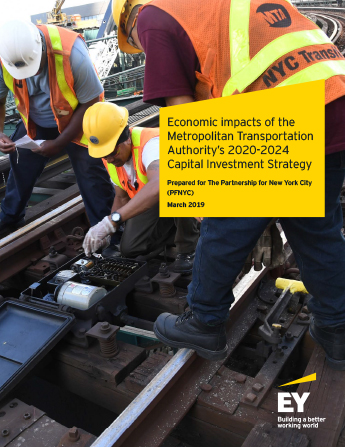Overview
The Metropolitan Transportation Authority (MTA) operates the largest transportation network in North America – averaging 2.6 billion riders annually across its subway, bus, and commuter rail systems. The MTA network serves one-third of all mass transit users in the United States and two-thirds of all US commuter rail passengers.
The MTA regularly prepares a Twenty-Year Needs Assessment after completing a system-wide inventory and condition assessment to determine State of Good Repair needs and reviewing changes in regional travel patterns, demographics, and economic trends.
This study, prepared for the Partnership of New York City by Ernst & Young Infrastructure Advisors, LLC examines the potential economic impacts of the MTA’s Capital Investment Strategy for the first five years of the MTA’s 2020-2039 Twenty-Year Needs Assessment on New York State and its 10 economic regions.
$62B
$62 billion of economic output will be generated statewide over 5 years from the MTA's estimated $44 billion capital expenditure.
57K
57,400 jobs supported by the program.
Report Highlights
The MTA Capital Investment Strategy will result in on-site construction and engineering services, as well as purchases of New York-manufactured equipment. This activity will support jobs, incomes, and business sales throughout NYS.
Statewide Impact
The analysis estimated that MTA’s $39.3 billion of spending with NYS vendors would support an average of 32,300 direct jobs per year – or one direct job for every $244,000 of spending.
Regional Impact
The majority of the direct impacts are supported in the NYC, Long Island, and Hudson Valley regions – primarily reflecting the location of construction and maintenance services performed on-site. The five boroughs of New York will capture $31.4 billion of the direct Capital Investment Strategy spend, or 80% of estimated instate expenditures.
Key Takeaways
The MTA capital investment strategy brings critical on-site construction and engineering services, as well as purchases of key equipment from manufactures in New York. It relies on the expertise and services of New York-based construction and engineering firms. Collectively, this activity supports both direct and indirect jobs and business revenues throughout the state.
